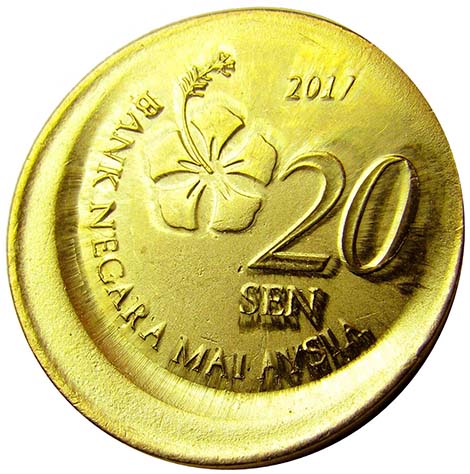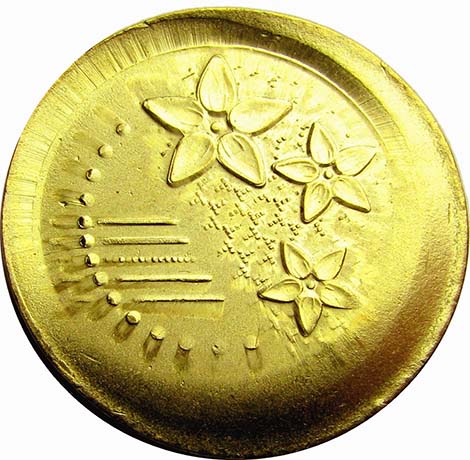Editor’s Note: Jeff Ylitalo was a former editor of CONECA’s Errorscope Magazine. He has decided to share part of his fantastic world error collection with the readers of Mint Error News Magazine.
PCGS Certifies Unique “Two Headed” Off-Metal
 This is one of three known U.S. or World coins struck by either two obverse or two reverse dies and struck on an off-metal planchet.
This is one of three known U.S. or World coins struck by either two obverse or two reverse dies and struck on an off-metal planchet.
 It is a Chile 10 Pesos struck with two obverse dies on a 1997 Bolivian 10 Cent copper plated steel planchet and weighs 2.22 grams. A normal Chilean 10 Pesos for this design is struck on an aluminum-bronze planchet and weighs 3.5 grams. It is the first ‘Two Headed or Two Tailed’ off-metal identified as being struck on an off-metal planchet intended for different country!
It is a Chile 10 Pesos struck with two obverse dies on a 1997 Bolivian 10 Cent copper plated steel planchet and weighs 2.22 grams. A normal Chilean 10 Pesos for this design is struck on an aluminum-bronze planchet and weighs 3.5 grams. It is the first ‘Two Headed or Two Tailed’ off-metal identified as being struck on an off-metal planchet intended for different country!
 It has been certified and authenticated (1997) PCGS 10 Pesos MS65RD - Chile struck with two obverse dies on 2.2 gram Bolivian 10 Cent planchet.
It has been certified and authenticated (1997) PCGS 10 Pesos MS65RD - Chile struck with two obverse dies on 2.2 gram Bolivian 10 Cent planchet.
 Two other unique coins are known to have been struck by either two obverse or two reverse dies on an off-metal planchet. The first is a unique two headed 1971 Great Britain ½ Pence struck with two obverse dies on a nickel-copper planchet and is certified by NGC. The other is a two tailed 2003 Chilean 5 Pesos struck with two reverse dies on a Chilean 1 Peso nickel-brass planchet and is certified by PCGS.
Two other unique coins are known to have been struck by either two obverse or two reverse dies on an off-metal planchet. The first is a unique two headed 1971 Great Britain ½ Pence struck with two obverse dies on a nickel-copper planchet and is certified by NGC. The other is a two tailed 2003 Chilean 5 Pesos struck with two reverse dies on a Chilean 1 Peso nickel-brass planchet and is certified by PCGS.
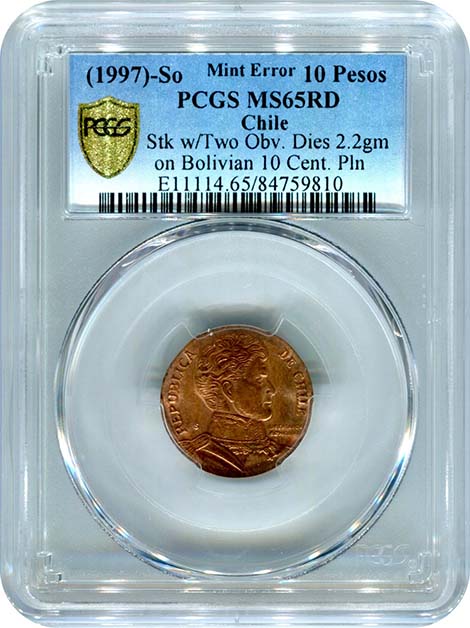
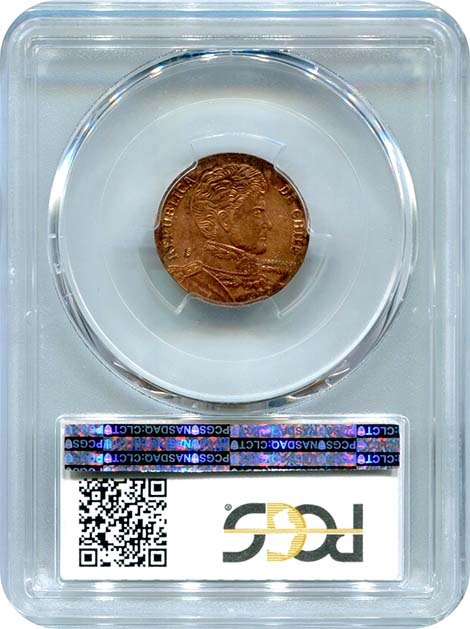
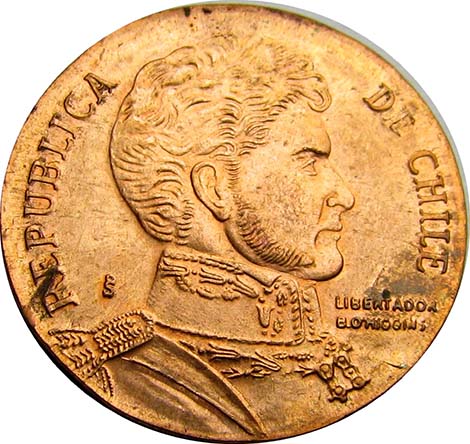
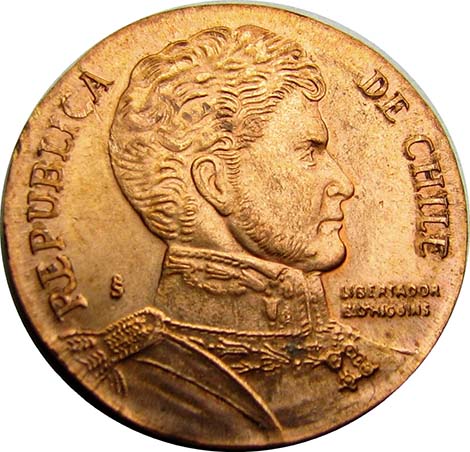


PCGS Certifies Unique “Casino Token” Mule
 This is the only known U.S. or World coin ever struck with a Casino Token die to be certified by ANACS, NGC or PCGS.
This is the only known U.S. or World coin ever struck with a Casino Token die to be certified by ANACS, NGC or PCGS.
 It is a 2006 dated 100 Pesos from Chile with the obverse being struck with a Casino Token die. It was recently certified by PCGS MS64 in July 2017.
It is a 2006 dated 100 Pesos from Chile with the obverse being struck with a Casino Token die. It was recently certified by PCGS MS64 in July 2017.
 The obverse design bears the image of an Owl dressed in a tuxedo perched on a tree stump. Below the image of the Owl are the die-struck letters “Bingo Begui”, which identifies the Casino name. Below this are the die-struck letters “Berazategui” which identifies the location of the Casino. Berazategui is a municipality of the larger metropolitan city of Buenos Aries, Argentina!
The obverse design bears the image of an Owl dressed in a tuxedo perched on a tree stump. Below the image of the Owl are the die-struck letters “Bingo Begui”, which identifies the Casino name. Below this are the die-struck letters “Berazategui” which identifies the location of the Casino. Berazategui is a municipality of the larger metropolitan city of Buenos Aries, Argentina!
 This is one of the most extraordinary, bizarre, and unexpected mules in U.S. or World Coins numismatic history to ever be discovered!
This is one of the most extraordinary, bizarre, and unexpected mules in U.S. or World Coins numismatic history to ever be discovered!
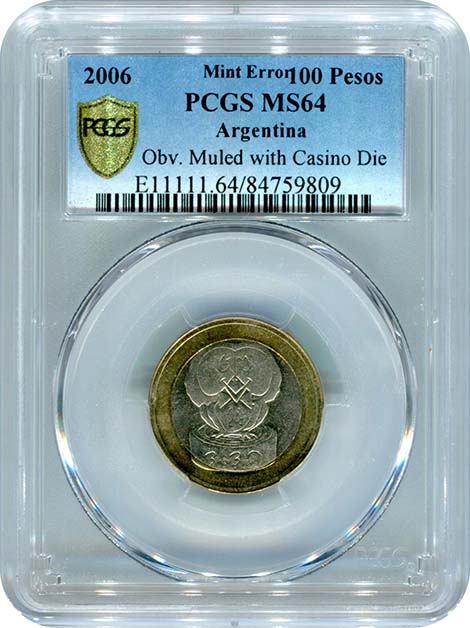
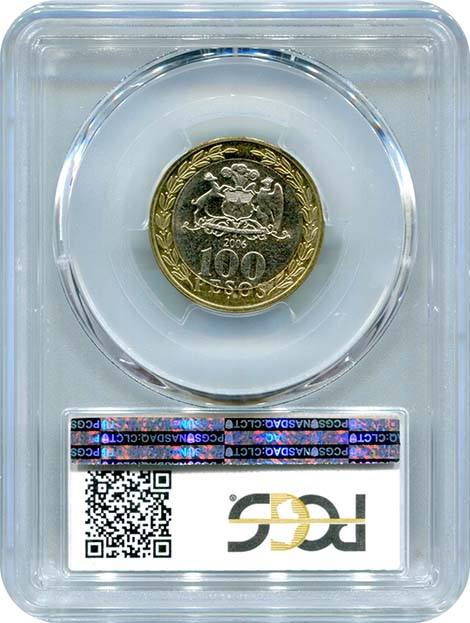
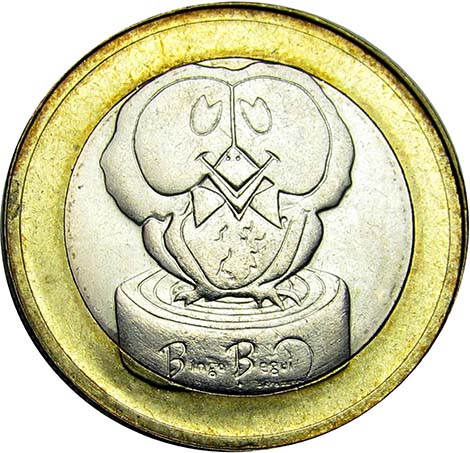
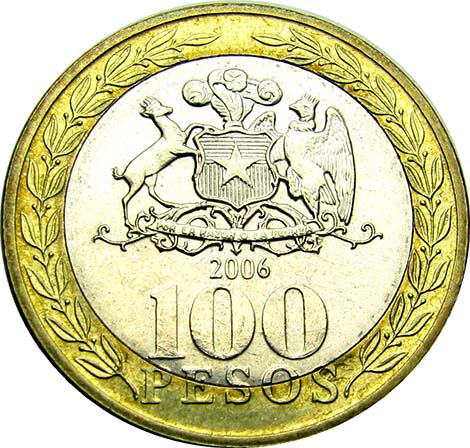


PCGS Certifies Unique “Two Headed” Bi-Metallic
 This is the first known U.S. or World Bi-Metallic coin struck by either two obverse or two reverse dies. It is a 100 Pesos from Chile struck with two obverse dies.
This is the first known U.S. or World Bi-Metallic coin struck by either two obverse or two reverse dies. It is a 100 Pesos from Chile struck with two obverse dies.
 When considering that most world mints strike the majority of circulating coinage on a solid disc of metal, the sheer number of solid disc planchets verses Bi-Metallic planchets is staggering.
When considering that most world mints strike the majority of circulating coinage on a solid disc of metal, the sheer number of solid disc planchets verses Bi-Metallic planchets is staggering.
 Bi-Metallic coins are struck on higher denomination planchets. This type of coin engineering aids in thwarting counterfeiters. The odds of a “Two Headed” or “Two Tailed” mule being struck on a Bi-Metallic are significantly reduced when all of this is taken into consideration. The U.S. strikes no Bi-metallic coins for general circulation.
Bi-Metallic coins are struck on higher denomination planchets. This type of coin engineering aids in thwarting counterfeiters. The odds of a “Two Headed” or “Two Tailed” mule being struck on a Bi-Metallic are significantly reduced when all of this is taken into consideration. The U.S. strikes no Bi-metallic coins for general circulation.
 There are approximately thirty one genuine two-headed or two-tailed coins authenticated by ANACS, PCGS or NGC. There are only four known “Two Tailed” U.S. coins: three Quarters and one Dime. There is just one “Two Headed” U.S. coin, a 2000-P Nickel.
There are approximately thirty one genuine two-headed or two-tailed coins authenticated by ANACS, PCGS or NGC. There are only four known “Two Tailed” U.S. coins: three Quarters and one Dime. There is just one “Two Headed” U.S. coin, a 2000-P Nickel.
 This Two Headed 100 Pesos from Chile was recently certified PCGS MS63.
This Two Headed 100 Pesos from Chile was recently certified PCGS MS63.
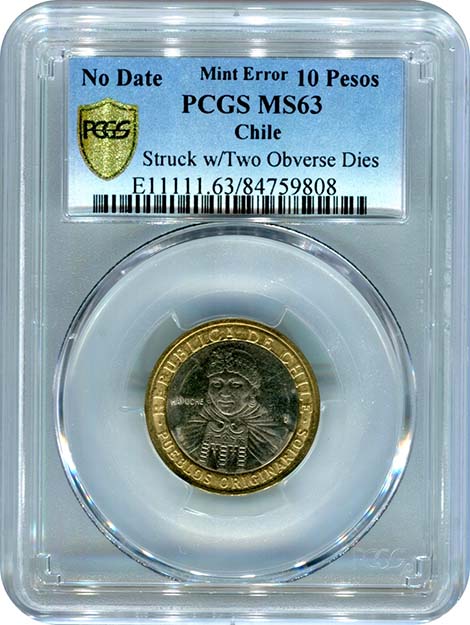
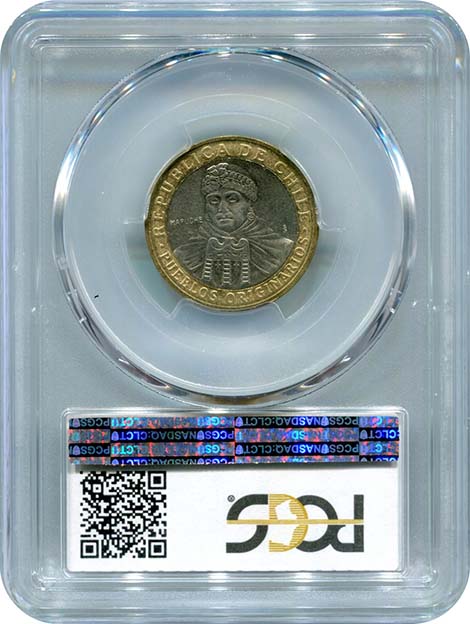
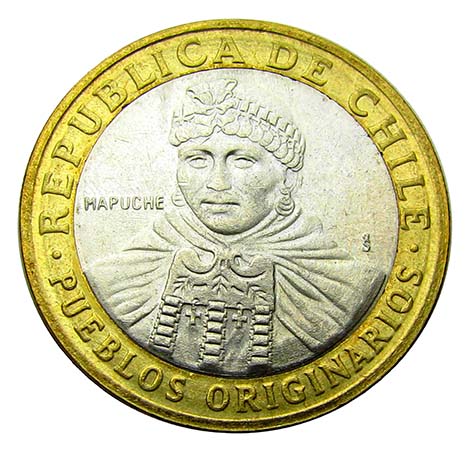
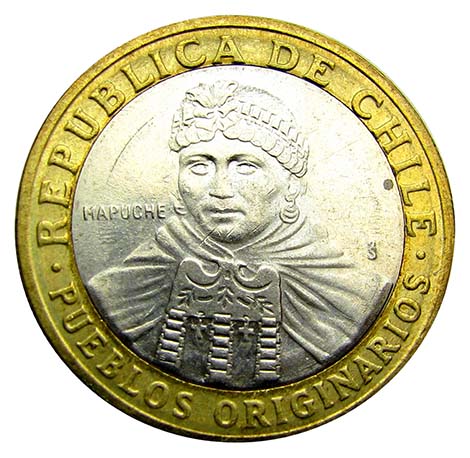


Mysterious “King Tutankamun” Error
 This is an Egyptian 1 Pound Bi-metallic coin that was weakly struck by King Tutankhamun dies used sometime during the years 2007 through 2011.
This is an Egyptian 1 Pound Bi-metallic coin that was weakly struck by King Tutankhamun dies used sometime during the years 2007 through 2011.
 The upper and lower devices of the funerary mask of King Tut can be clearly seen struck on the core obverse.
The upper and lower devices of the funerary mask of King Tut can be clearly seen struck on the core obverse.
 A minimum of four years passed when it was mysteriously struck with several closely spaced off-center strikes by a pair of Egyptian 2015 Suez Canal dies!
A minimum of four years passed when it was mysteriously struck with several closely spaced off-center strikes by a pair of Egyptian 2015 Suez Canal dies!
 The combination of striking errors along with two die designs separated by at least four years is amazing!
The combination of striking errors along with two die designs separated by at least four years is amazing!
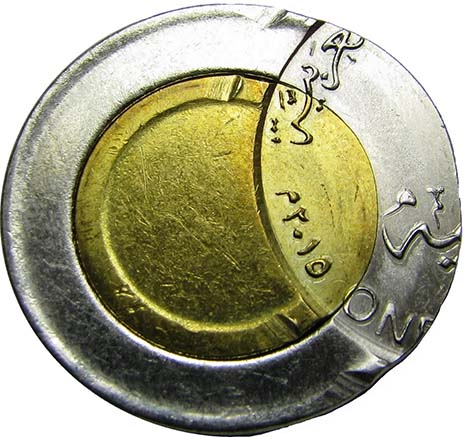
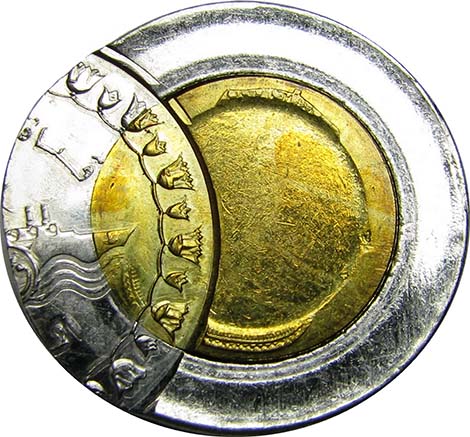


Rare “Dual Country Dual Denomination”
 This type of major error is exceedingly rare. It is a 2009 25 Centavos from Argentina that was over struck by 50 Pesos dies from Chile!
This type of major error is exceedingly rare. It is a 2009 25 Centavos from Argentina that was over struck by 50 Pesos dies from Chile!
 Here, the already struck 2009 25 Centavos which is 24 mm in diameter found its way in the coining chamber striking 50 Pesos from Chile. The 50 Pesos coin is 25 mm in diameter and therefore would easily strike any coin equal to or less in size.
Here, the already struck 2009 25 Centavos which is 24 mm in diameter found its way in the coining chamber striking 50 Pesos from Chile. The 50 Pesos coin is 25 mm in diameter and therefore would easily strike any coin equal to or less in size.
 The 25 centavos reverse was struck by the 50 pesos obverse die. The 25 centavos obverse was struck by the 50 pesos reverse die.
The 25 centavos reverse was struck by the 50 pesos obverse die. The 25 centavos obverse was struck by the 50 pesos reverse die.
 My research indicates the Santiago Mint in Chile strikes coinage for a host of countries. These include:
My research indicates the Santiago Mint in Chile strikes coinage for a host of countries. These include:
Argentina
Bolivia
Brazil
Costa Rica
Dominican Republic
Ecuador
Guatemala
Israel
Nicaragua
Paraguay
Uruguay
The Santiago Mint also strikes gaming tokens for casinos in Argentina, Ecuador, Thailand and South Africa.
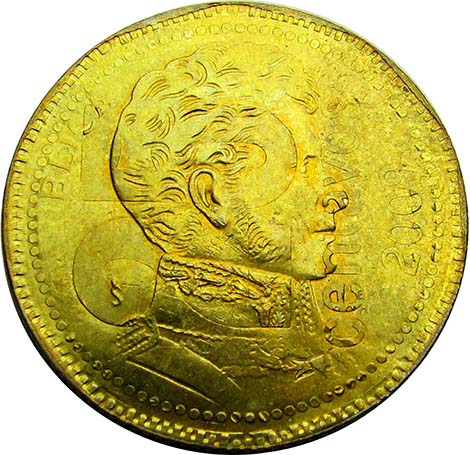
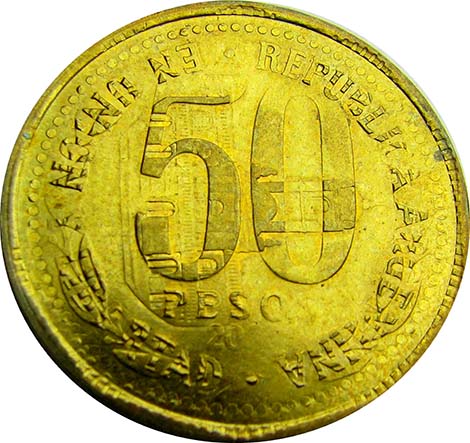
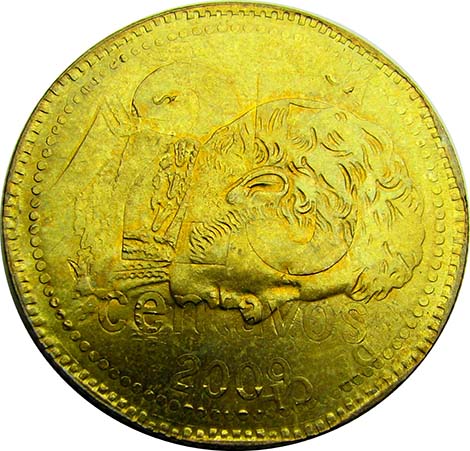
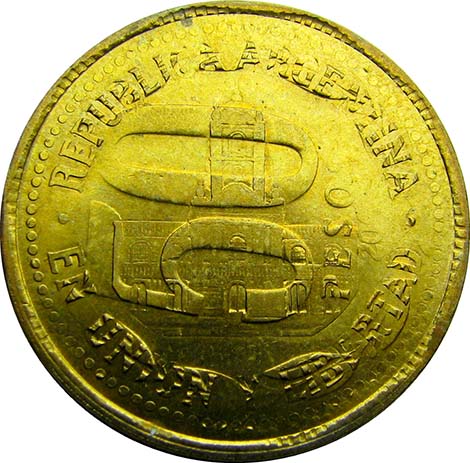


Struck Through “Feeder Finger” Errors
 One of the rarest “Struck Thru” errors to locate are those that have been impacted by a feed finger. In the error hobby it is as important to identify the object responsible for a struck-through error as it is to establish the rarity or value of such a striking error. After all, a coin with the generic description ‘indented’ or “struck through” does not give justice to rarely encountered types of struck through errors such as impressions of washers, hex nuts, and feeder fingers.
One of the rarest “Struck Thru” errors to locate are those that have been impacted by a feed finger. In the error hobby it is as important to identify the object responsible for a struck-through error as it is to establish the rarity or value of such a striking error. After all, a coin with the generic description ‘indented’ or “struck through” does not give justice to rarely encountered types of struck through errors such as impressions of washers, hex nuts, and feeder fingers.
 When a feeder finger is struck, the feeder is rendered useless, discarded and replaced with another. Think about it; how many coins at most are going to be struck by a malfunctioning feeder? Not too many. Such errors are extremely rare, misunderstood and under-appreciated.
When a feeder finger is struck, the feeder is rendered useless, discarded and replaced with another. Think about it; how many coins at most are going to be struck by a malfunctioning feeder? Not too many. Such errors are extremely rare, misunderstood and under-appreciated.
 It is not difficult to determine whether a coin has been struck thru by a feeder finger. Most importantly, the shape of the struck-through region often includes a sharp angle that marks the corner of the feeder finger tip. The floor of the indentation usually shows a texture vastly different from that left by a planchet, sometimes smooth and sometimes coarse. A dark discoloration may be present in the floor of the indentation. Coins are often struck multiple times and are split or torn apart when struck through a feeder finger. It often creates a very dramatic error unlike anything else!
It is not difficult to determine whether a coin has been struck thru by a feeder finger. Most importantly, the shape of the struck-through region often includes a sharp angle that marks the corner of the feeder finger tip. The floor of the indentation usually shows a texture vastly different from that left by a planchet, sometimes smooth and sometimes coarse. A dark discoloration may be present in the floor of the indentation. Coins are often struck multiple times and are split or torn apart when struck through a feeder finger. It often creates a very dramatic error unlike anything else!
 Here are some exciting, one of a kind examples from across the world!
Here are some exciting, one of a kind examples from across the world!
A 2009 25 Centavos from Argentina. This coin was struck at least ten times on the obverse. It features two separate but parallel indentations from a feeder finger on the reverse making it a unique one of a kind error!
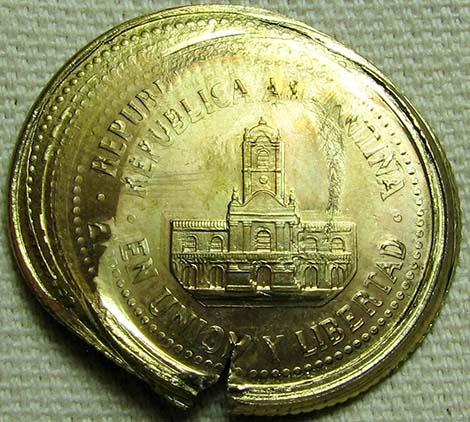
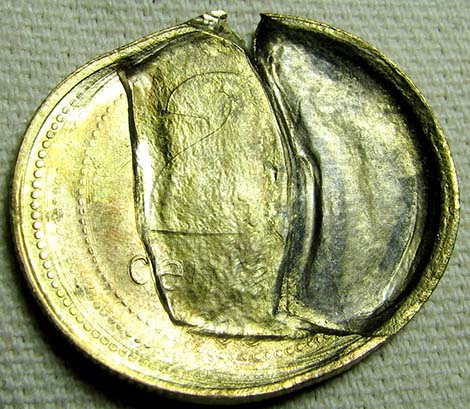 A 2006 two pound Isambard Kingdom Brunel bi-metallic coin from the United Kingdom. This coin has been struck at least twice on the reverse. It features an indentation from a feeder finger on the obverse. The impression retains the original shape and size of a feeder finger. This specimen is an unrivaled monster!
A 2006 two pound Isambard Kingdom Brunel bi-metallic coin from the United Kingdom. This coin has been struck at least twice on the reverse. It features an indentation from a feeder finger on the obverse. The impression retains the original shape and size of a feeder finger. This specimen is an unrivaled monster!
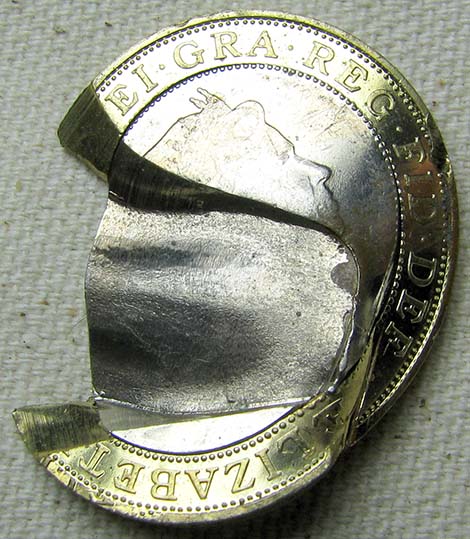
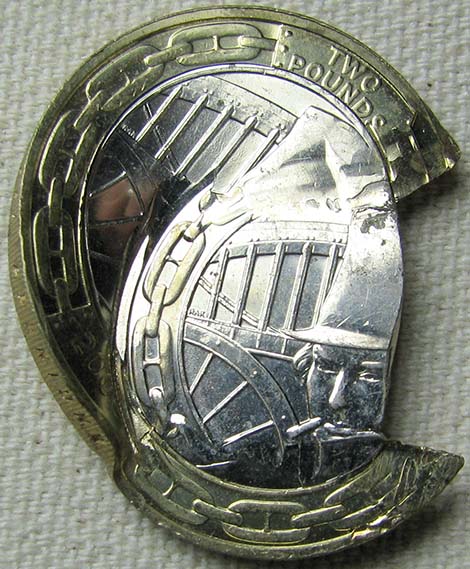 A 2009 50 Pesos from Chile. This coin has been multi-struck and features an indentation from a feeder finger on the obverse.
A 2009 50 Pesos from Chile. This coin has been multi-struck and features an indentation from a feeder finger on the obverse.
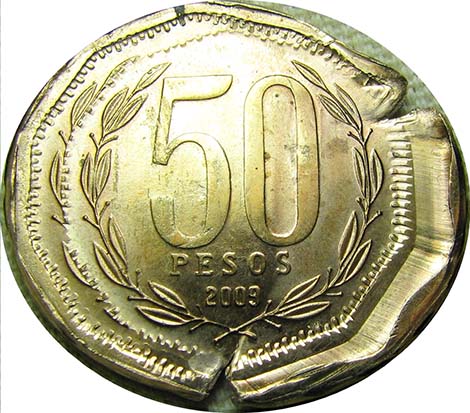
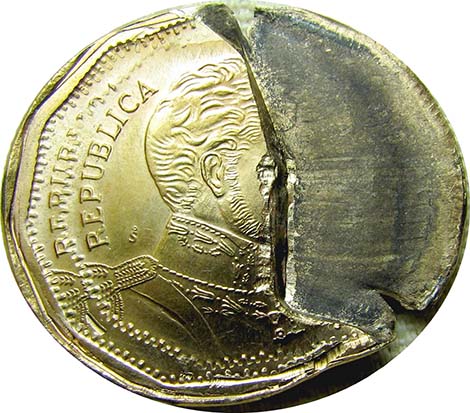 A 2011 100 Guaranies from Paraguay. This coin has been multi-struck and features an indentation from a feeder finger on the reverse.
A 2011 100 Guaranies from Paraguay. This coin has been multi-struck and features an indentation from a feeder finger on the reverse.
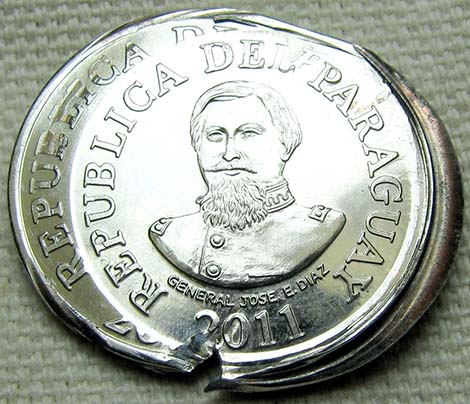
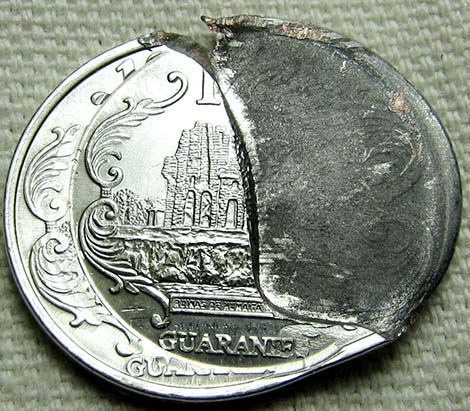 A 2010 20 centavos from Bolivia. This coin has been struck at least three times on the obverse. It features an indentation from a feeder finger on the reverse.
A 2010 20 centavos from Bolivia. This coin has been struck at least three times on the obverse. It features an indentation from a feeder finger on the reverse.
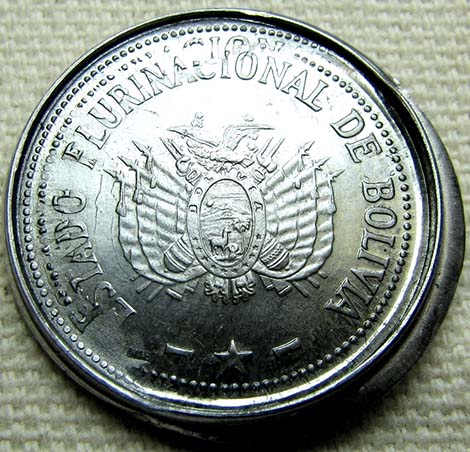
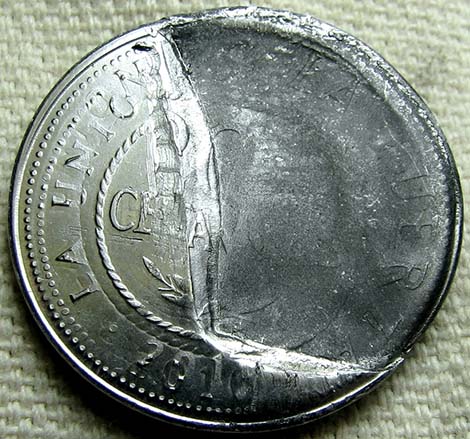 A 2007 20 sen coin from Malaysia. This coin has been struck at least five times on the reverse. It features an indentation from a feeder finger on the obverse.
A 2007 20 sen coin from Malaysia. This coin has been struck at least five times on the reverse. It features an indentation from a feeder finger on the obverse.
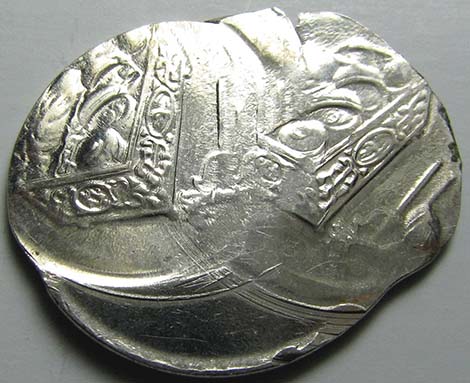
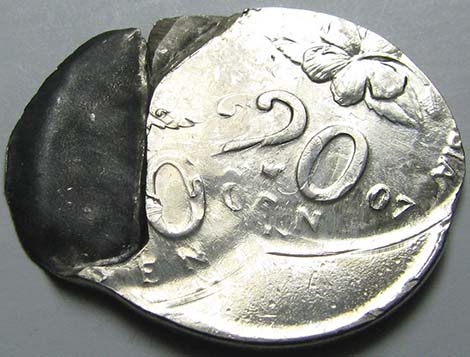 A 2010 1 Boliviano. This coin has been multi-struck and features an indentation from a feeder finger on the reverse. The impression retains the original shape and size of a feeder finger. Design elements present in the floor of the impression include the denomination and the letters LIVIAN of BOLIVIANO. The feeder finger intruded after the first strike and remained in place through subsequent strikes.
A 2010 1 Boliviano. This coin has been multi-struck and features an indentation from a feeder finger on the reverse. The impression retains the original shape and size of a feeder finger. Design elements present in the floor of the impression include the denomination and the letters LIVIAN of BOLIVIANO. The feeder finger intruded after the first strike and remained in place through subsequent strikes.
Note: The lower image shows a feeder and one the fingers struck by 1 Boliviano dies. The struck finger fits neatly into the indentation and demonstrates the depth and contours of the impression.
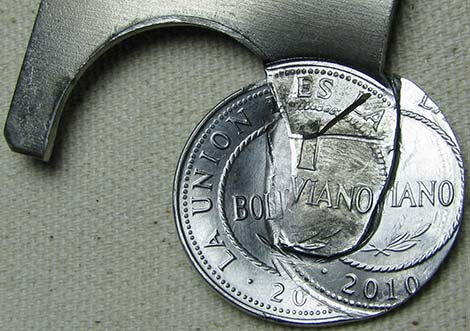 A 2010 20 centavos from Bolivia. This coin has been struck at least three times on the obverse. It features an indentation from a feeder finger on the reverse.
A 2010 20 centavos from Bolivia. This coin has been struck at least three times on the obverse. It features an indentation from a feeder finger on the reverse.
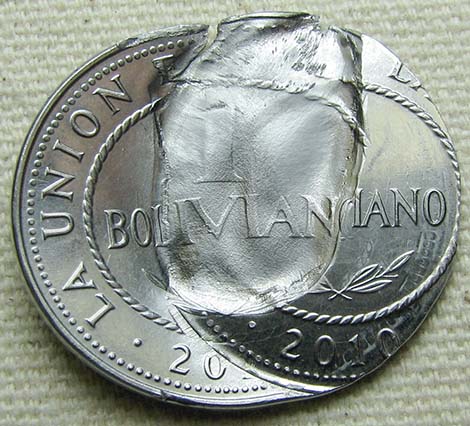
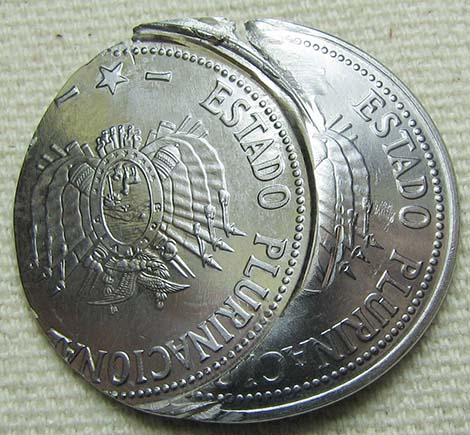 A 2007 20 sen coin from Malaysia. This coin has been struck at least five times on the reverse. It features an indentation from a feeder finger on the obverse.
A 2007 20 sen coin from Malaysia. This coin has been struck at least five times on the reverse. It features an indentation from a feeder finger on the obverse.
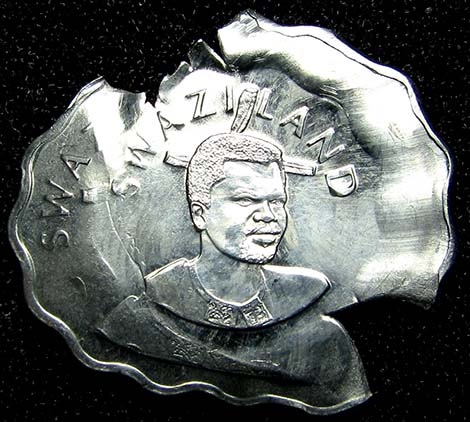
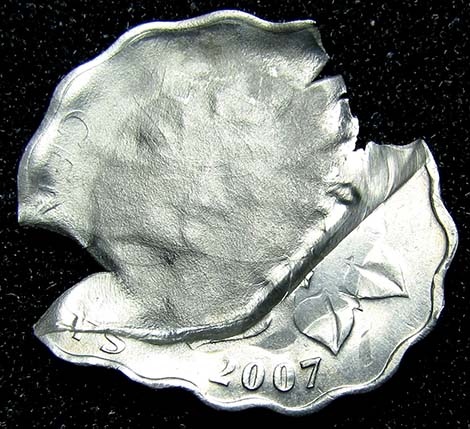 Recent History of Feeder Finger Errors
Recent History of Feeder Finger Errors

In the early 1990’s the US Mint began using feeders composed of aluminum. Aluminum feeders are assumed to be still in use today at U.S. Mint facilities since struck aluminum feeder finger fragments carry a range of dates from 1993 to at least 2007 and include every denomination. Naturally, collectors snap up examples of these struck fragments whenever possible. By design, these aluminum feeder fingers break apart when struck. Light and brittle, they help protect and extend the life of working dies and other components by breaking apart when they accidentally land between the dies.

U.S. coins that have unquestionably been struck-through feeder fingers are very difficult to locate. Since aluminum feeder fingers are designed to break apart, this limits the number and availability of this type of striking error.

Many foreign mints employ steel feeders. Their fingers do not break apart so easily when struck by working dies. This is very good news for error collectors because it translates into a number of struck feeders left wholly intact. The struck feeder fingers can, in turn, help authenticate coins suspected as having been ‘struck-though’ a feeder finger. As with coins from the U.S. they are still a very tough error to find; remember that once a feeder has been struck it must be replaced!


“Off-Metal” World Coins Struck on Other Country Planchets
 An exotic type of planchet error that warrants special attention involves crossing country borders.
An exotic type of planchet error that warrants special attention involves crossing country borders.
 Off-Metal errors are fun, but when a minting facility in one country strikes its own coin design on another countries planchet, things start to get very interesting!
Off-Metal errors are fun, but when a minting facility in one country strikes its own coin design on another countries planchet, things start to get very interesting!
 Here are five exciting modern examples that are outstanding and rarely publicized!
Here are five exciting modern examples that are outstanding and rarely publicized!
A 2007 Great Britain 1 Pound Gateshead Millennium Bridge struck on a isolated 1 Euro core. The core has a groove round the edge, is magnetic as it should be, and weighs exactly what a core for a 1 Euro Bi-metallic coin should. The Gateshead 1 Pound was minted for just one year. It is known that the British Royal Mint strikes Euro coinage for Ireland. A unique error combination! This coin has recently been certified and authenticated by PCGS MS62.
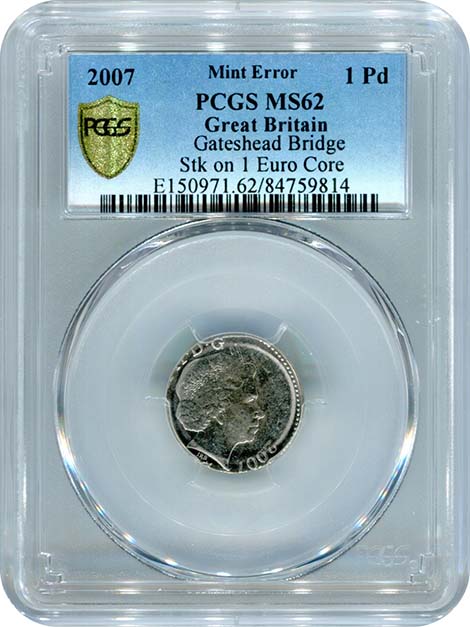
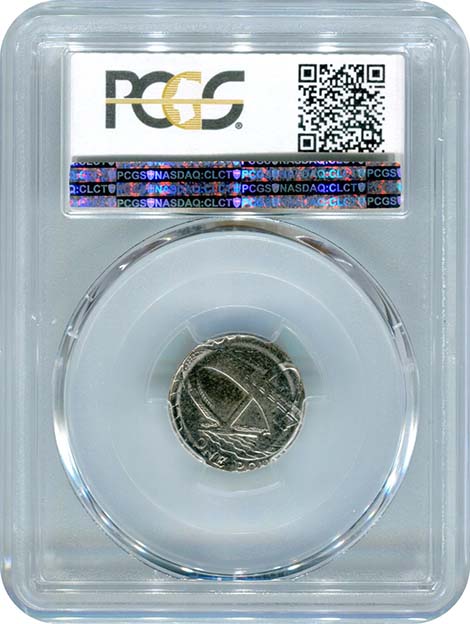
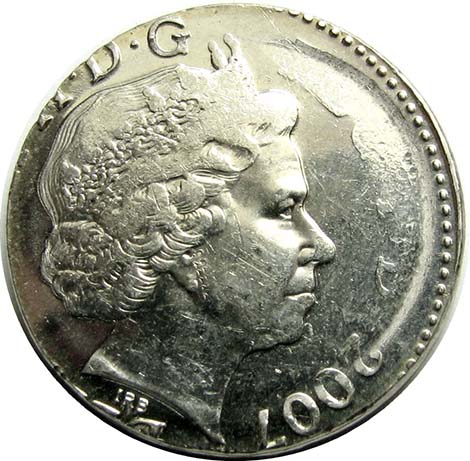
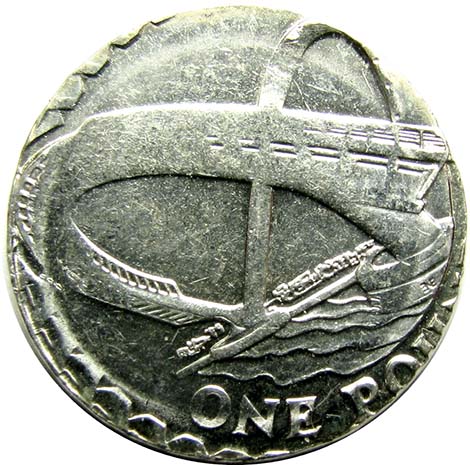
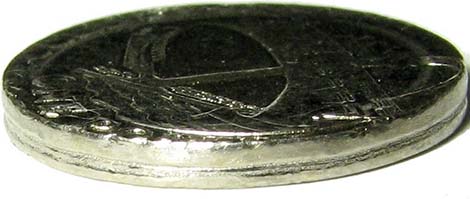 A 2010 Bolivian 5 Bolivianos struck on a bronze planchet intended for a Chilean 10 pesos. The 5 Bolivianos is normally struck on a Bi-metallic planchet!
A 2010 Bolivian 5 Bolivianos struck on a bronze planchet intended for a Chilean 10 pesos. The 5 Bolivianos is normally struck on a Bi-metallic planchet!
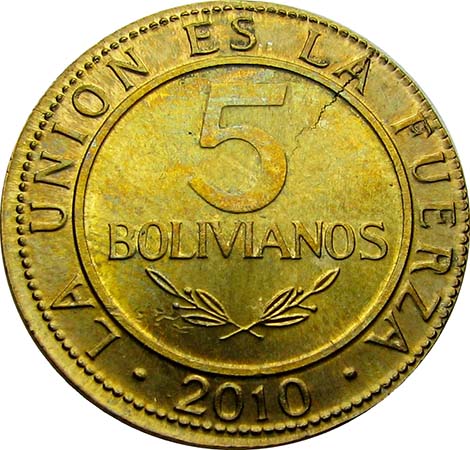
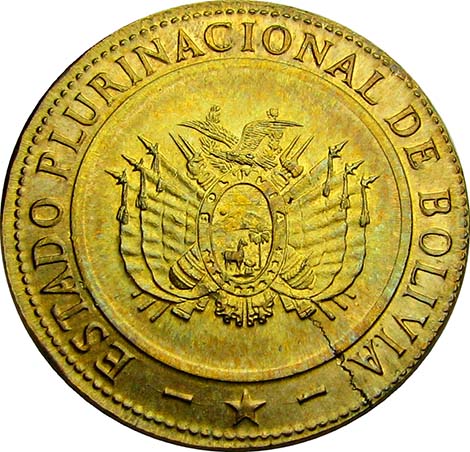 A 2005 Chilean 100 Pesos struck on an aluminum planchet intended for a Costa Rica 5 colones. The 100 Pesos is normally struck on a Bi-metallic planchet. This error also is a misaligned error and has a major rotation of the striking dies!
A 2005 Chilean 100 Pesos struck on an aluminum planchet intended for a Costa Rica 5 colones. The 100 Pesos is normally struck on a Bi-metallic planchet. This error also is a misaligned error and has a major rotation of the striking dies!
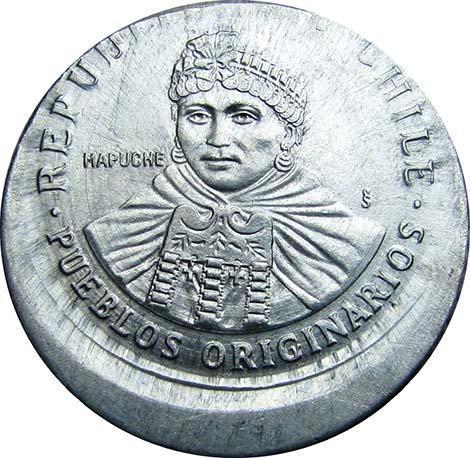
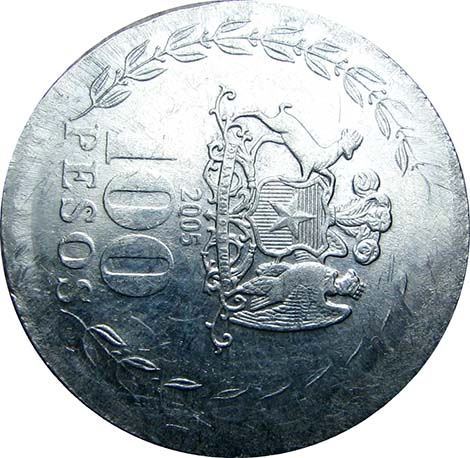 A 2010 Chilean 100 pesos struck on a stainless-steel planchet intended for a Bolivian 20 centavos.
A 2010 Chilean 100 pesos struck on a stainless-steel planchet intended for a Bolivian 20 centavos.
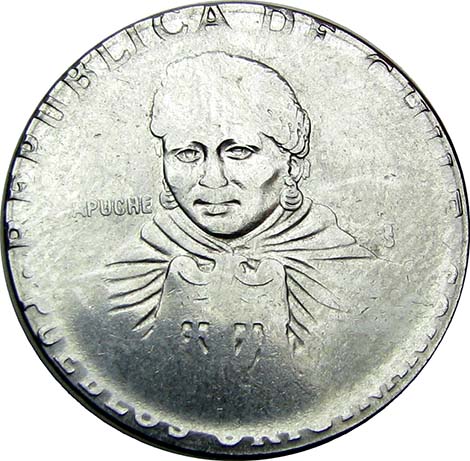
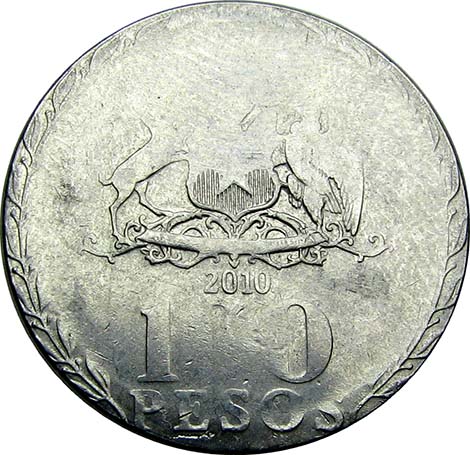 An Iceland 10 Krona struck on an isolated Bi-metallic core, country unknown. The planchet has a groove round the edge proving it was intended to be a core for a Bi-metallic coin. Iceland has never had a bi-metal coin in its entire history!
An Iceland 10 Krona struck on an isolated Bi-metallic core, country unknown. The planchet has a groove round the edge proving it was intended to be a core for a Bi-metallic coin. Iceland has never had a bi-metal coin in its entire history!
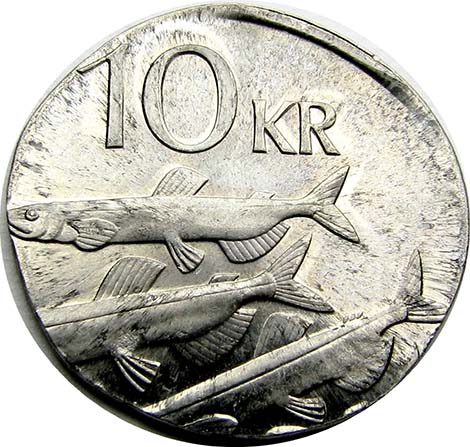
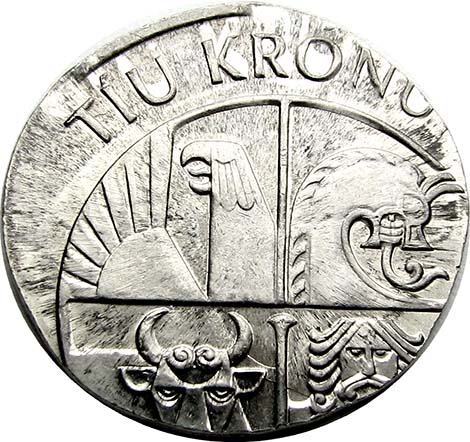



Bi-metallic Coins Struck by Different Denomination Dies
 Very few Bi-metallic coins (or their components) are known that have been struck by a pair of different denomination dies. This makes sense as the sheer number of world-wide solid metal planchets being struck verses a much smaller and restricted population of Bi-metallic planchets is astonishing.
Very few Bi-metallic coins (or their components) are known that have been struck by a pair of different denomination dies. This makes sense as the sheer number of world-wide solid metal planchets being struck verses a much smaller and restricted population of Bi-metallic planchets is astonishing.
Bi-metallic coins are struck in higher denominations and on a much larger planchet than most of their smaller denomination brethren.
Taking all of this into consideration, the chances of a Bi-metallic planchet finding its way into a press striking solid metal planchets are nearly infinitesimal.
Here are the only three examples I’ve encountered over the last 20 years. I consider them to be unique. I know of a fourth which is a spectacular 2000-P Sacagawea dollar struck on copper-nickel ring intended for a Ghana 100 Cedis and sold for a modest price of $3,737.00 in the 2008 Orlando January FUN Auction.
A Chile 2006 50 Pesos struck on a Chile 100 Pesos Bi-metallic planchet. A 100 Pesos being smaller than a 50 Pesos, it would easily fit into the striking chamber. A 50 Pesos for this date is struck on an aluminum bronze planchet.
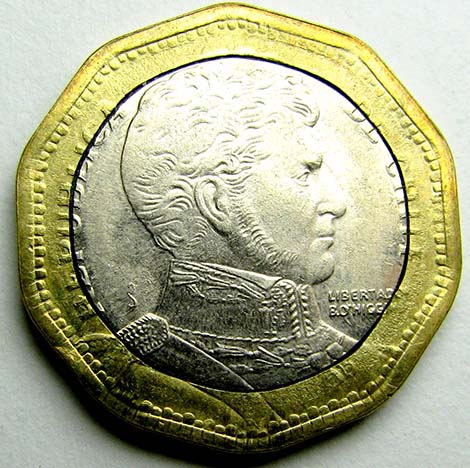
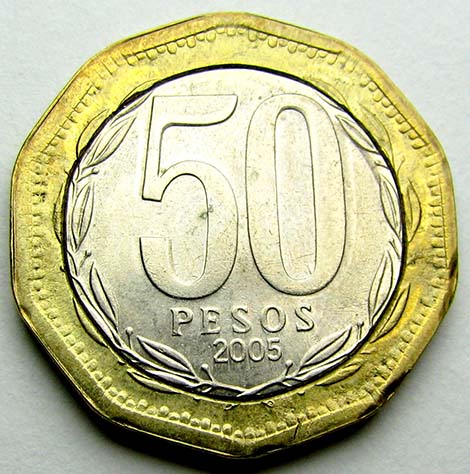 An Egyptian 2010 50 Piastres struck on an unknown magnetic Bi-metallic ring. Weight is 2.44 grams and is plated steel. It is known that the British Royal Mint strikes coinage for Egypt. A 50 Piastres for this date is normally struck on an very thick brass plated steel planchet. The obverse shows the upper head-dress and lower bust of Cleopatra’s head. The reverse shows the denomination.
An Egyptian 2010 50 Piastres struck on an unknown magnetic Bi-metallic ring. Weight is 2.44 grams and is plated steel. It is known that the British Royal Mint strikes coinage for Egypt. A 50 Piastres for this date is normally struck on an very thick brass plated steel planchet. The obverse shows the upper head-dress and lower bust of Cleopatra’s head. The reverse shows the denomination.
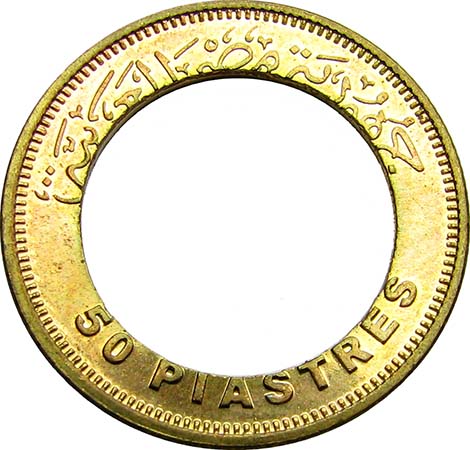
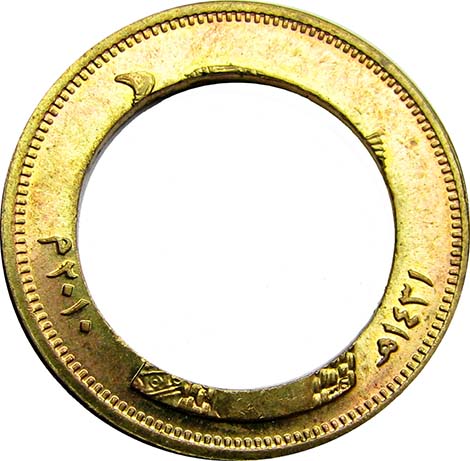 A Chile 2006 10 Pesos struck on a Chile 100 Pesos Bi-metallic planchet. A 100 Pesos planchet is just slightly larger than a 10 Pesos and this error was likely helped. A 10 Pesos for this date is struck on an aluminum bronze planchet.
A Chile 2006 10 Pesos struck on a Chile 100 Pesos Bi-metallic planchet. A 100 Pesos planchet is just slightly larger than a 10 Pesos and this error was likely helped. A 10 Pesos for this date is struck on an aluminum bronze planchet.
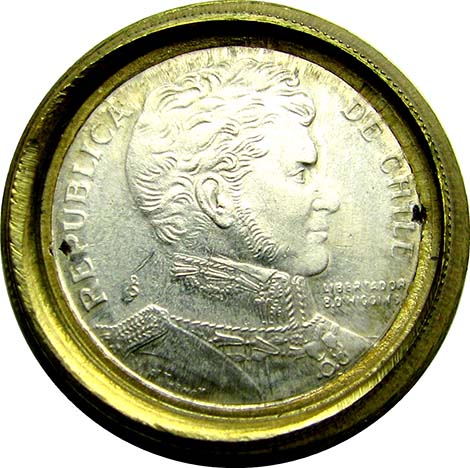
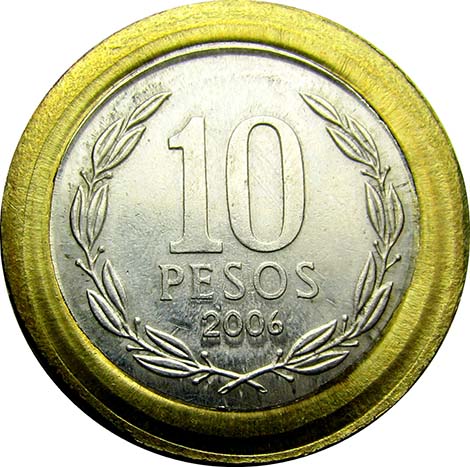


Off-Metal Ring & Off-Metal Core Errors
 Bi-metallic errors having either an off-metal ring or core are rare. I have encountered and collected just a handful over the years.
Bi-metallic errors having either an off-metal ring or core are rare. I have encountered and collected just a handful over the years.
The first is a unique Great Britain 2 Pound coin with the Technology design on the reverse. The off-metal ring is presumably an industrial steel washer! It is strongly attracted to a magnetic and has a fairly rough surface unlike any type of normal planchet. The color of the ring is gun-metal grey and the coin is 3.3 grams under normal weight. A normal 2 Pound ring is composed of nickel-brass and is not magnetic.
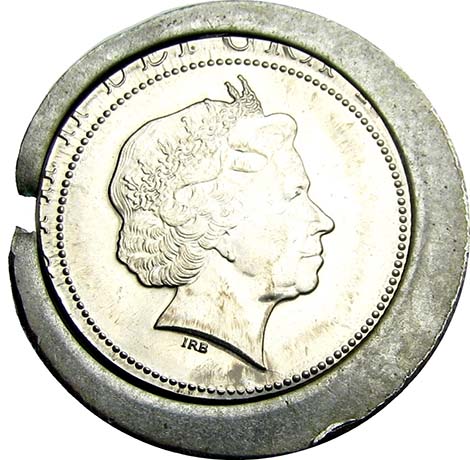
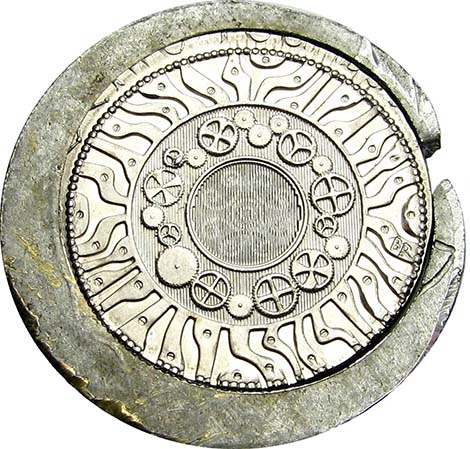 Next is a unique 2006 Great Britain 2 Pound coin with the Technology design on the reverse. The coin is 3.0 grams underweight with the core being thinner than normal. It is comprised of steel which is strongly attracted to a magnet. A normal 2 Pound core is comprised of cupro-nickel and is not magnetic.
Next is a unique 2006 Great Britain 2 Pound coin with the Technology design on the reverse. The coin is 3.0 grams underweight with the core being thinner than normal. It is comprised of steel which is strongly attracted to a magnet. A normal 2 Pound core is comprised of cupro-nickel and is not magnetic.
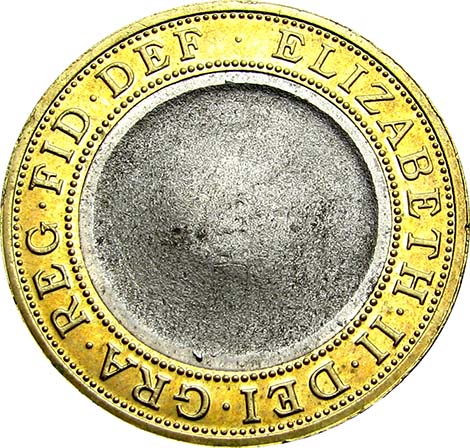
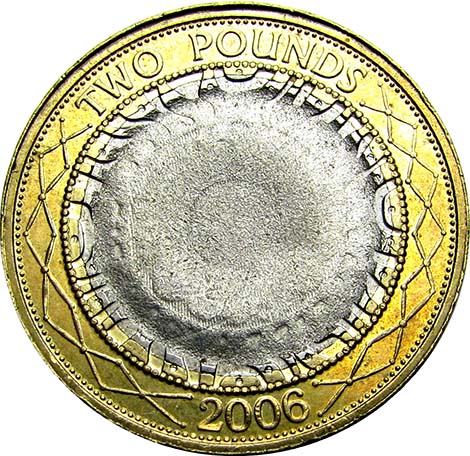 Next is a unique 2005 Chilean 100 Pesos with an off-metal core. The coin is normal in size but it is just over half the weight that it should be at a mere 3.9 grams. In this case, the core is comprised of lightweight aluminum! A normal 100 pesos is comprised of copper-nickel and is not magnetic. No Bi-metallic coin in history has ever used it as a primary base metal for either a ring or a core. The Santiago mint strikes coins for a number of countries that do use aluminum planchets for their coinage.
Next is a unique 2005 Chilean 100 Pesos with an off-metal core. The coin is normal in size but it is just over half the weight that it should be at a mere 3.9 grams. In this case, the core is comprised of lightweight aluminum! A normal 100 pesos is comprised of copper-nickel and is not magnetic. No Bi-metallic coin in history has ever used it as a primary base metal for either a ring or a core. The Santiago mint strikes coins for a number of countries that do use aluminum planchets for their coinage.
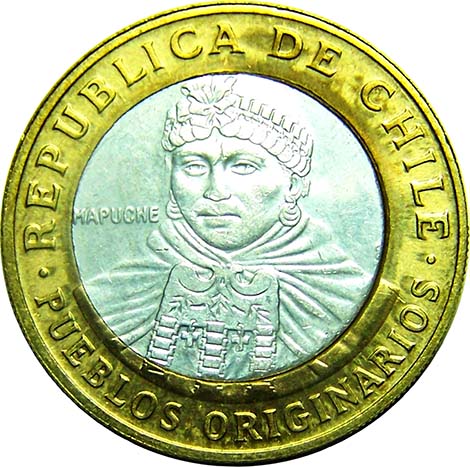
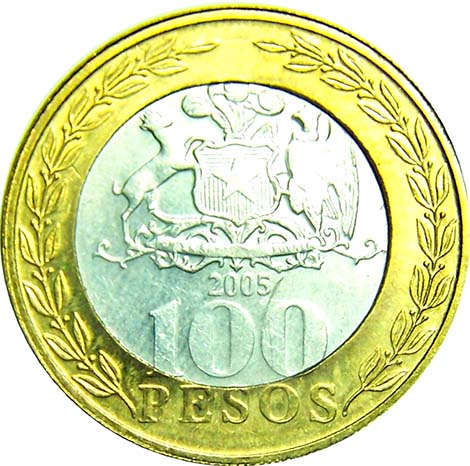


Large Clips on Bi-Metallic Coins
 Locating large major clips on Bi-metallic coins can be a daunting task. They are scarce to rare and are visually stunning when compared to clips on solid denomination coins.
Locating large major clips on Bi-metallic coins can be a daunting task. They are scarce to rare and are visually stunning when compared to clips on solid denomination coins.
The first specimen is a 2 Pound Scottish of the Union coin from Great Britain with a large curved clip. It is by weight a 28% clip of the outer ring. This coin design was struck for one year in 2007.
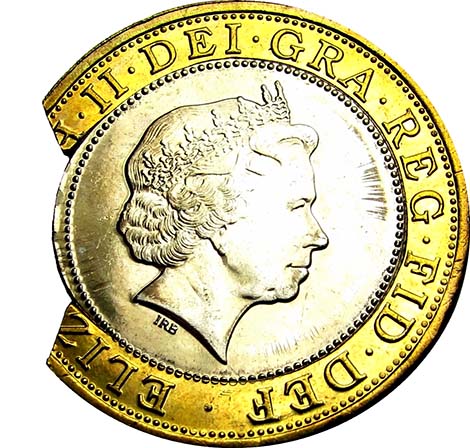
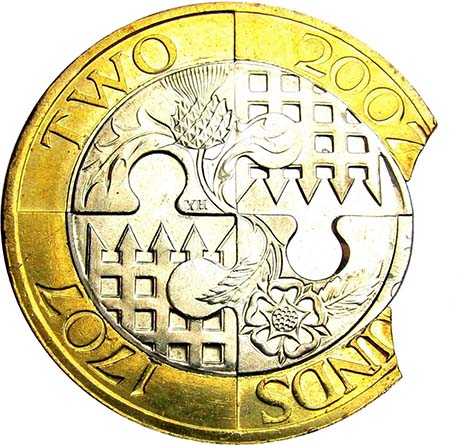 The second clipped coin is a 10 Pesos commemorative coin from Mexico that has a solid silver core surrounded by an aluminum bronze ring. Dated 1993 it is struck off-center with the ring having a large straight clip. By weight it is a 30% clip. This is the only major straight clip I have encountered on a Bi-metallic coin.
The second clipped coin is a 10 Pesos commemorative coin from Mexico that has a solid silver core surrounded by an aluminum bronze ring. Dated 1993 it is struck off-center with the ring having a large straight clip. By weight it is a 30% clip. This is the only major straight clip I have encountered on a Bi-metallic coin.
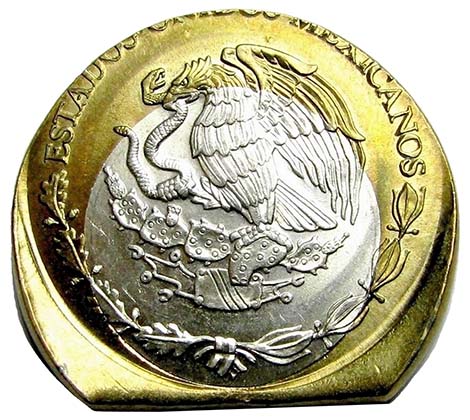
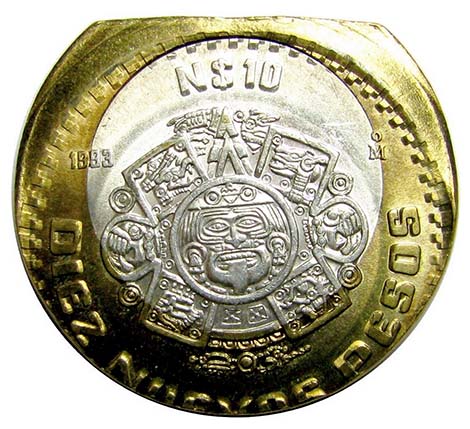


Unique 2 Euro Error
 This is a unique 2 Euro Bi-metallic coin from Germany and dated 2002 with Hamburg mintmark (J). Two layers of the trilaminar core have fallen away after being struck!
This is a unique 2 Euro Bi-metallic coin from Germany and dated 2002 with Hamburg mintmark (J). Two layers of the trilaminar core have fallen away after being struck!
 The core is made up of three layers. The middle layer is comprised of elemental nickel. The two outer layers are referred to as ‘Nordic gold’ and comprised of 75% copper, 20% zinc and 5% nickel.
The core is made up of three layers. The middle layer is comprised of elemental nickel. The two outer layers are referred to as ‘Nordic gold’ and comprised of 75% copper, 20% zinc and 5% nickel.
 In this case, the Nordic gold outer layer of the reverse and the middle layer of nickel are absent.
In this case, the Nordic gold outer layer of the reverse and the middle layer of nickel are absent.
This is an exceedingly rare error type and I’ve seen just one other which is a 1 Euro Bi-metallic from Belgium missing one outer Nordic gold layer and the middle nickel layer.
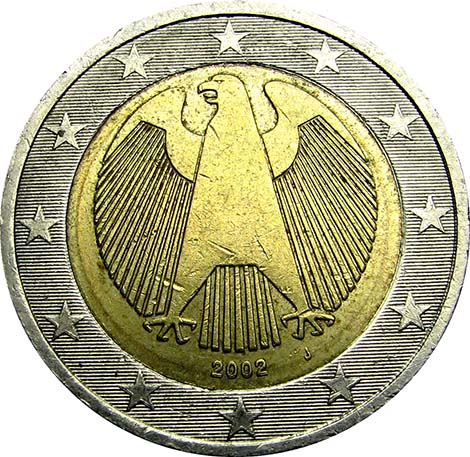
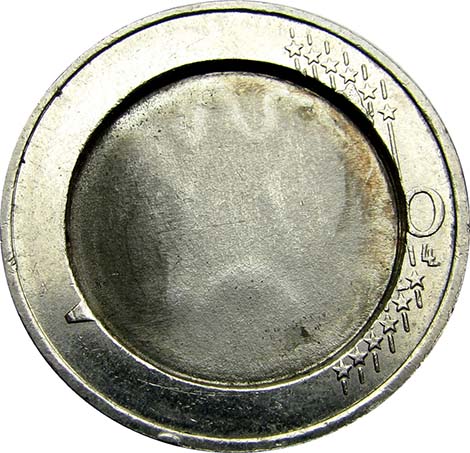


Off Center & Misaligned Core Errors
 This type of striking error only occurs on Bi-metallic coins. They are eagerly sought by collectors from around the world for their dramatic appearance. The most highly prized are that whose core remain intact with the ring and have expanded far enough to reach the edge of the coin.
This type of striking error only occurs on Bi-metallic coins. They are eagerly sought by collectors from around the world for their dramatic appearance. The most highly prized are that whose core remain intact with the ring and have expanded far enough to reach the edge of the coin.
A Bi-metallic core can be struck off center for a few reasons. The middle hole of the ring may have been incorrectly punched and misshapen during the blanking process. The core may not be the right size or it simply was not seated properly. This major misalignment positions the core in an off center location on top of the ring.
A 2007 Slovenian 2 Euro.
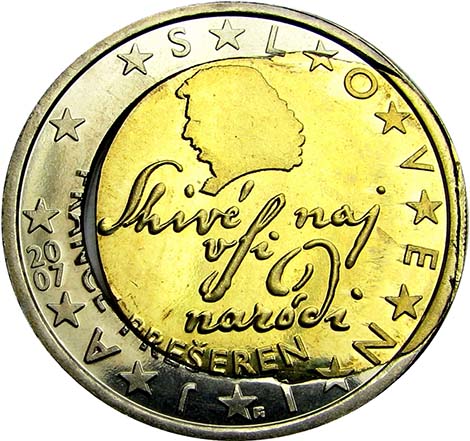
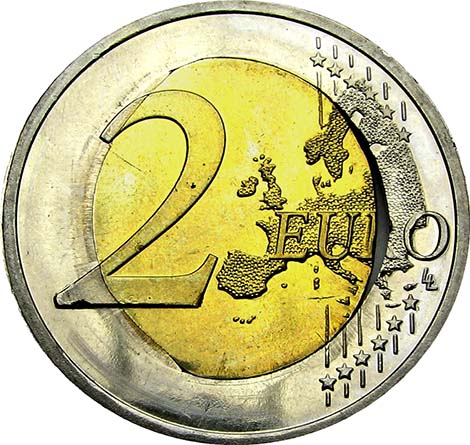 A 2005 Kenyan 5 Shillings.
A 2005 Kenyan 5 Shillings.
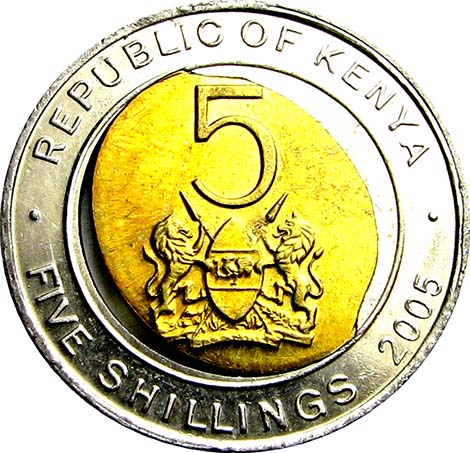
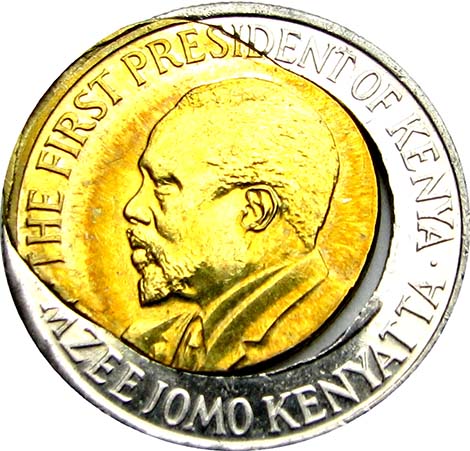 A 1998 Sri Lankan 10 Rupees that remains precariously joined with the ring.
A 1998 Sri Lankan 10 Rupees that remains precariously joined with the ring.
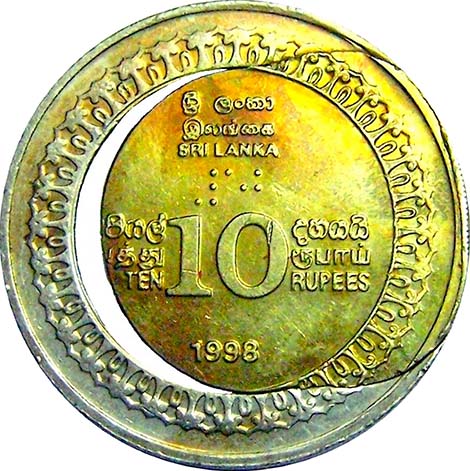
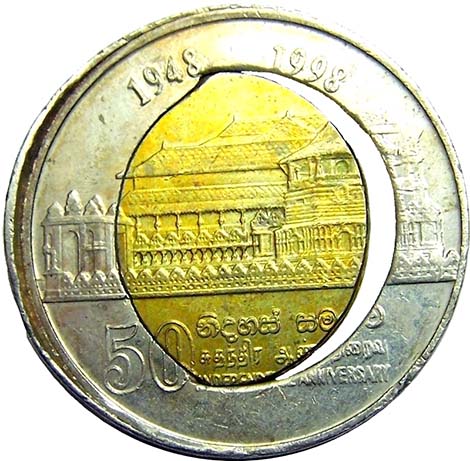
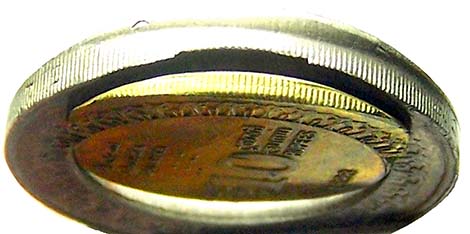


Malaysian Assisted Errors
 Error coins struck at the Malaysian mint include an assortment of assisted or ‘helped’ coins. When these errors appear on the market, enthusiasts quickly snatch them up as they are very collectible and eagerly sought out.
Error coins struck at the Malaysian mint include an assortment of assisted or ‘helped’ coins. When these errors appear on the market, enthusiasts quickly snatch them up as they are very collectible and eagerly sought out.
 Many creative combinations of planchet, die, and striking errors have been encountered. Most were struck during the second series of coins 1989 – 2011 but with an emphasis during the years 2005-2007.
Many creative combinations of planchet, die, and striking errors have been encountered. Most were struck during the second series of coins 1989 – 2011 but with an emphasis during the years 2005-2007.
 The third series of coin design from Malaysia, 2012 - present, eliminated the 1 sen coin from circulation. Assisted errors from the third series have less of a presence but they can be found by collectors exercising due diligence and a keen eye.
The third series of coin design from Malaysia, 2012 - present, eliminated the 1 sen coin from circulation. Assisted errors from the third series have less of a presence but they can be found by collectors exercising due diligence and a keen eye.
A mule coin, this is a normal 2005 10 sen planchet struck with a normal 10 sen reverse die that was paired with a smaller denomination 1 sen obverse die.
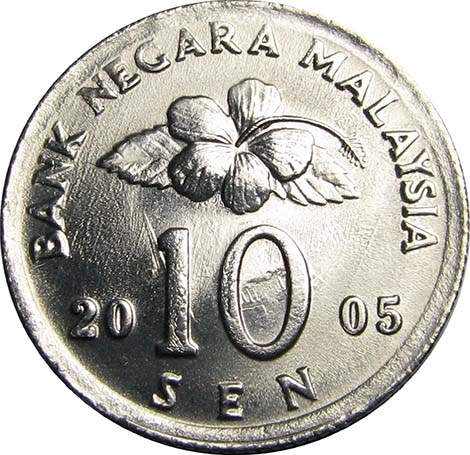
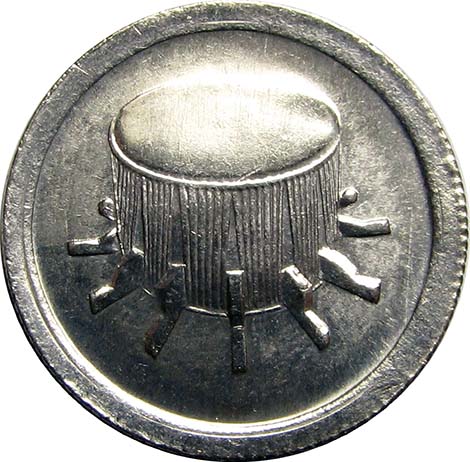 A 2005 10 sen struck on larger 20 sen planchet.
A 2005 10 sen struck on larger 20 sen planchet.
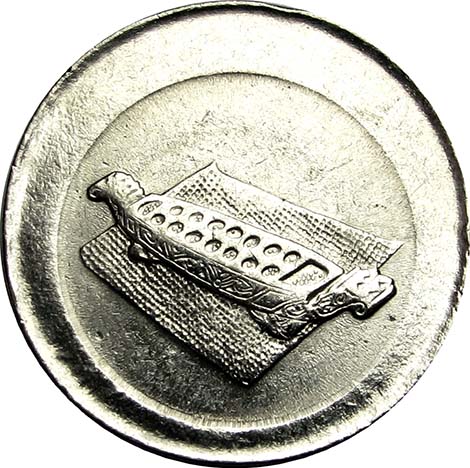
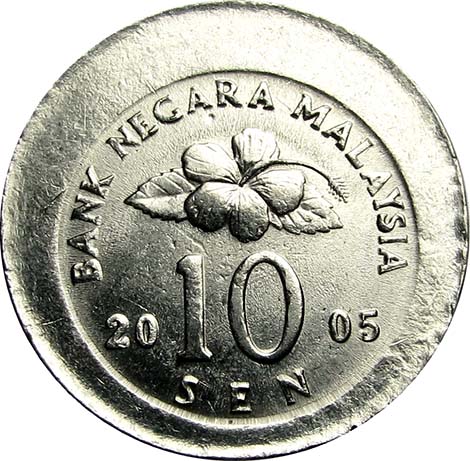 A 2006 20 sen struck on larger 50 sen planchet.
A 2006 20 sen struck on larger 50 sen planchet.
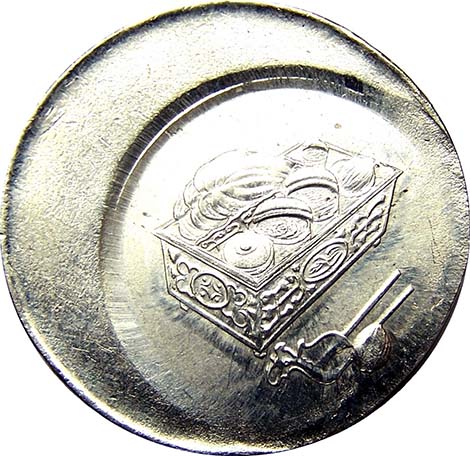
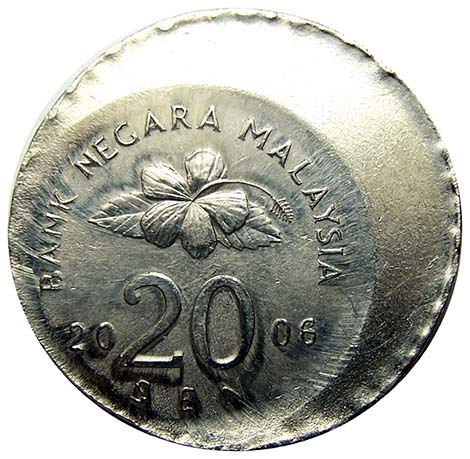 A 2005 die struck 50 sen over struck by 2007 dated 50 sen dies.
A 2005 die struck 50 sen over struck by 2007 dated 50 sen dies.
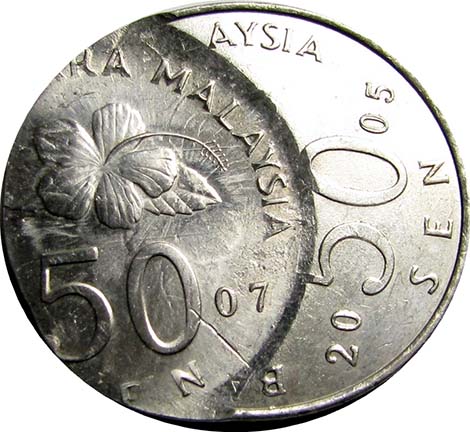
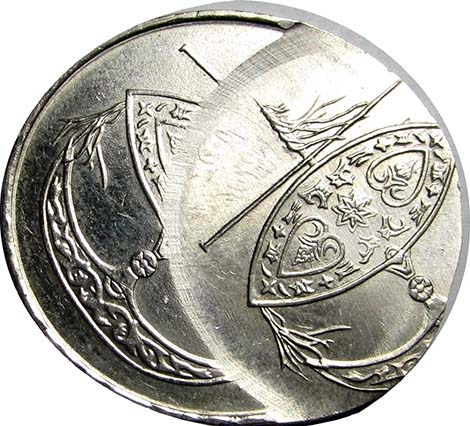 A die struck 50 sen over struck by 20 sen dies.
A die struck 50 sen over struck by 20 sen dies.
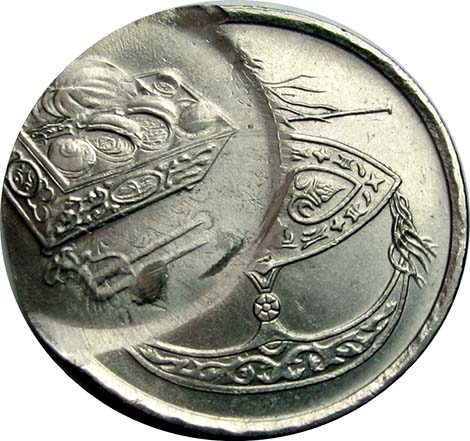
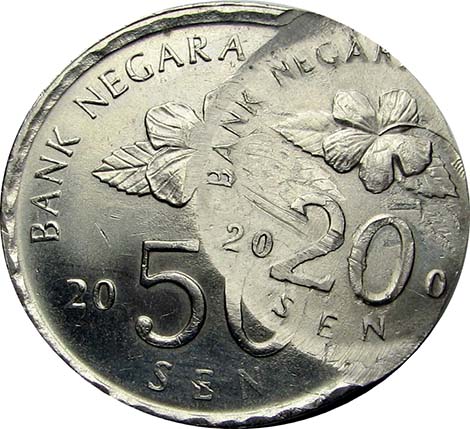 A 2007 10 sen flip-over, triple struck with each strike show a full date.
A 2007 10 sen flip-over, triple struck with each strike show a full date.
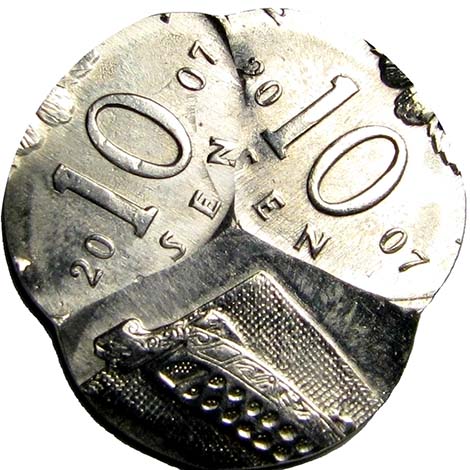
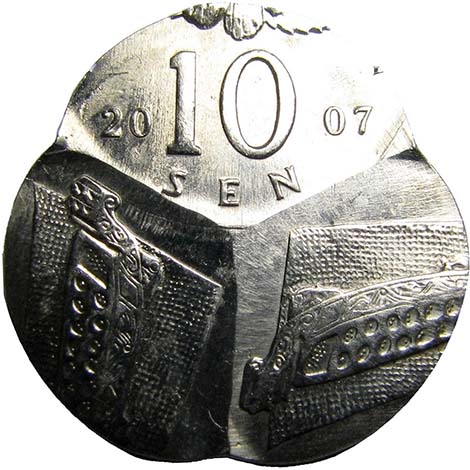 A 2017 Malaysian 20 sen struck on a larger 50 sen planchet and is also an off-metal error. A normal 50 sen planchet is comprised of a thick copper core that is sandwiched by a nickel-brass clad layer on either face. The metal composition for a normal 20 sen planchet is a solid nickel-brass alloy that does not have a clad layer.
A 2017 Malaysian 20 sen struck on a larger 50 sen planchet and is also an off-metal error. A normal 50 sen planchet is comprised of a thick copper core that is sandwiched by a nickel-brass clad layer on either face. The metal composition for a normal 20 sen planchet is a solid nickel-brass alloy that does not have a clad layer.
